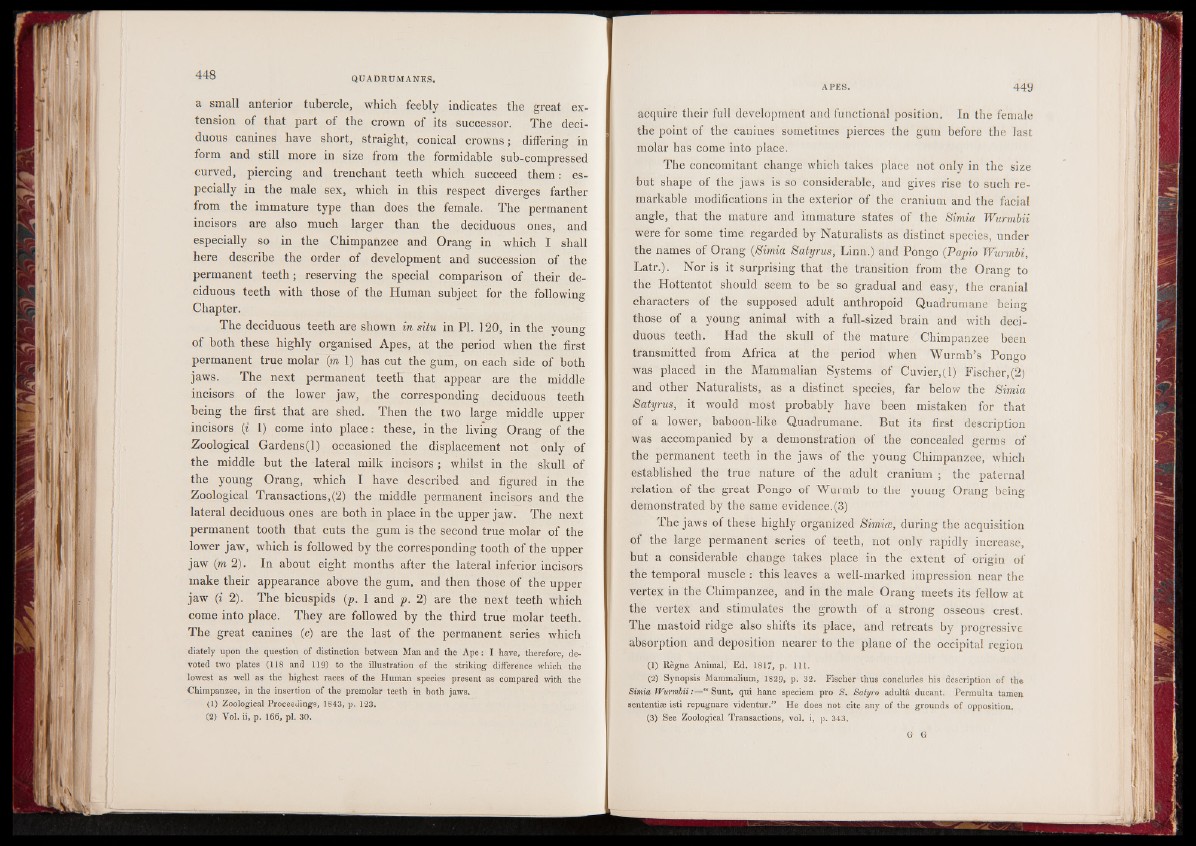
a small anterior tubercle, which feebly indicates the great ex-
tension of that part of the crown of its successor. The deciduous
canines have short, straight, conical crowns; differing in
form and still more in size from the formidable sub-compressed
curved, piercing and trenchant teeth which succeed them: especially
in the male sex, which in this respect diverges farther
from the immature type than does the female. The permanent
incisors are also much larger than the deciduous ones, and
especially so in the Chimpanzee and Orang in which I shall
here describe the order of development and succession of the
permanent teeth; reserving the special comparison of their deciduous
teeth with those of the Human subject for the following
Chapter.
The deciduous teeth are shown in situ in PL 120, in the young
of both these highly organised Apes, at the period when the first
permanent true molar (to 1) has cut the gum, on each side of both
jaws. The next permanent teeth that appear are the middle
incisors of the lower jaw, the corresponding deciduous teeth
being the first that are shed. Then the two large middle upper
incisors (i 1) come into place: these, in the living Orang of the
Zoological Gardens(l) occasioned the displacement not only of
the middle but the lateral milk incisors ; whilst in the skull of
the young Orang, which I have described and figured in the
Zoological Transactions,(2) the middle permanent incisors and the
lateral deciduous ones are both in place in the upper jaw. The next
permanent tooth that cuts the gum is the second true molar of the
lower jaw, which is followed by the corresponding tooth of the upper
jaw (m2). In about eight months after the lateral inferior incisors
make their appearance above the gum, and then those of the upper
jaw (i 2). The bicuspids (p. 1 and p. 2) are the next teeth which
come into place. They are followed by the third true molar teeth.
The great canines (c) are the last of the permanent series which
diately upon the question of distinction between Man and the Ape: I have, therefore, devoted
two plates (118 and 119) to the illustration of the striking difference which the
lowest as well as the highest races of the Human species present as compared with the
Chimpanzee, in the insertion of the premolar teeth in both jaws.
(1) Zoological Proceedings, 1843, p. 123.
(2) Vol. ii, p. 166, pi. 30.
acquire their full development and functional position. In the female
the point of the canines sometimes pierces the gum before the last
molar has come into place.
The concomitant change which takes place not only in the size
but shape of the jaws is so considerable, and gives rise to such remarkable
modifications in the exterior of the cranium and the facial
angle, that the mature and immature states of the Simia Wurmbii
were for some time regarded by Naturalists as distinct species, under
the names of Orang (Simia Satyrus, Linn.) and Pongo (.Papio Wurmbi,
Latr.). Nor is it surprising that the transition from the Orang to
the Hottentot should seem to be so gradual and easy, the cranial
characters of the supposed adult anthropoid Quadrumane being
those of a young animal with a full-sized brain and with deciduous
teeth. Had the skull of the mature, Chimpanzee been
transmitted from Africa at the period when Wurmb’s Pongo
was placed in the Mammalian Systems of Cuvier,(l) Fischer,(2)
and other Naturalists, as a distinct species, far below the Simia
Satyrus, it would most probably have been mistaken for that
of a lower, baboon-like Quadrumane. But its first description
was accompanied by a demonstration of the concealed germs of
the permanent teeth in the jaws of the young Chimpanzee, which
established the true nature of the adult cranium ; the paternal
relation of the great Pongo of Wurmb to the young Orang being
demonstrated by the same evidence. (3)
The jaws of these highly organized Simiæ, during the acquisition
of the large permanent series of teeth, not only rapidly increase,
but a considerable change takes place in the extent of origin of
the temporal muscle : this leaves a well-marked impression near the
vertex in the Chimpanzee, and in the male Orang meets its fellow at
the vertex and stimulates the growth of a strong osseous crest.
The mastoid ridge also shifts its place, and retreats by progressive
absorption and deposition nearer to the plane of the occipital region
(1) Règne Animal, Ed. 1817, p. 111.
(2) Synopsis Mammalium, 1829, p. 32. Fischer thus concludes his description of the
Simia Wurmbii :—“ Sunt, qui hanc speciem pro £, Satyro adultâ ducant. Permulta tamen
sententiæ isti repugnare videntur.” He does not cite any of the grounds of opposition.
(3) See Zoological Transactions, vol. i, p. 343.
G G